Flags of Our Fathers
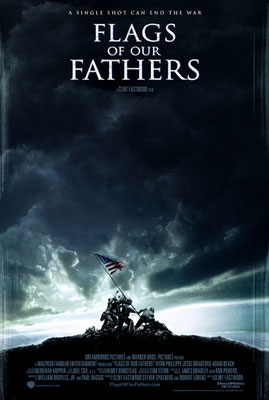
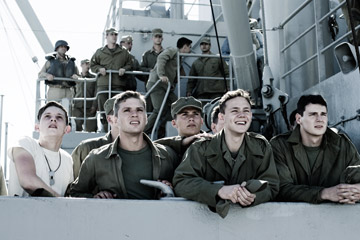 Flags of Our Fathers attempts to tell the true story behind the famous photograph that inspired the US war effort when hope was starting to fade. The photo in question concerned a group of soldiers working together to raise an American flag atop a mountain during the Battle of Iwo Jima. Three men who were present that day, and helped raise a second replacement flag, are brought home and treated as heroes. They are medical officer John "Doc" Bradley (Ryan Phillippe), glory seeking Rene Gagnon (Jesse Bradford) and sorrowful Native American soldier Ira Hayes (Adam Beach). The men have been sent on a promotional tour to help raise money for the war effort, and increase sales in Bonds. Of course, the men are haunted by the memories of the Battle, and the truth behind what really happened the day the flag was raised. They are made to keep quiet by the media and their superiors, as their very image and the story of their actions has swelled up patriotism in the American people. The film follows the three men as they react to the fame thrust upon them in different ways, and the impact that the event had on their lives.
Flags of Our Fathers attempts to tell the true story behind the famous photograph that inspired the US war effort when hope was starting to fade. The photo in question concerned a group of soldiers working together to raise an American flag atop a mountain during the Battle of Iwo Jima. Three men who were present that day, and helped raise a second replacement flag, are brought home and treated as heroes. They are medical officer John "Doc" Bradley (Ryan Phillippe), glory seeking Rene Gagnon (Jesse Bradford) and sorrowful Native American soldier Ira Hayes (Adam Beach). The men have been sent on a promotional tour to help raise money for the war effort, and increase sales in Bonds. Of course, the men are haunted by the memories of the Battle, and the truth behind what really happened the day the flag was raised. They are made to keep quiet by the media and their superiors, as their very image and the story of their actions has swelled up patriotism in the American people. The film follows the three men as they react to the fame thrust upon them in different ways, and the impact that the event had on their lives.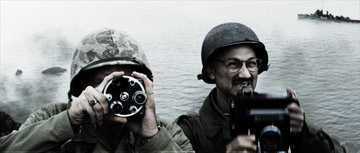 The film is not so much a war movie, as it is a story about morality and how the government can twist a single moment into something far greater in order to stir up support for a cause many people have grown weary of. The screenplay by William Broyles, Jr (Jarhead) and Paul Haggis (Crash, The Last Kiss) focuses on each of these three men and their different reactions to the war. This is when the film is at its best. Watching the three men smile for the cameras in each publicity event, we can see the nervousness in their eyes. They know that they are not the heroes that the media is selling them as, but yet, just what defines a hero anyway? It is a word that can mean one thing to so many different people. Are the men who died during the attack on Iwo Jima the true heroes? Are these three men heroes for helping raise support for a cause that has been dwindling? Are the other men featured in the photo who lost their lives afterward the heroes? The movie offers no easy answers, and allows us to reach our own conclusions. As the men make their way across the US, different moments stir memories. The most striking sequence occurs when one of the men sees an ice cream mold in the shape of the flag photo having strawberry flavored topping poured over it, almost making the "soldiers" in the mold look like they are bleeding. In the wrong hands, something like this could come across as manipulative or a case of bombastic imagery. But Eastwood knows not to dwell on the symbolism, and just let the image hit hard like it should.
The film is not so much a war movie, as it is a story about morality and how the government can twist a single moment into something far greater in order to stir up support for a cause many people have grown weary of. The screenplay by William Broyles, Jr (Jarhead) and Paul Haggis (Crash, The Last Kiss) focuses on each of these three men and their different reactions to the war. This is when the film is at its best. Watching the three men smile for the cameras in each publicity event, we can see the nervousness in their eyes. They know that they are not the heroes that the media is selling them as, but yet, just what defines a hero anyway? It is a word that can mean one thing to so many different people. Are the men who died during the attack on Iwo Jima the true heroes? Are these three men heroes for helping raise support for a cause that has been dwindling? Are the other men featured in the photo who lost their lives afterward the heroes? The movie offers no easy answers, and allows us to reach our own conclusions. As the men make their way across the US, different moments stir memories. The most striking sequence occurs when one of the men sees an ice cream mold in the shape of the flag photo having strawberry flavored topping poured over it, almost making the "soldiers" in the mold look like they are bleeding. In the wrong hands, something like this could come across as manipulative or a case of bombastic imagery. But Eastwood knows not to dwell on the symbolism, and just let the image hit hard like it should.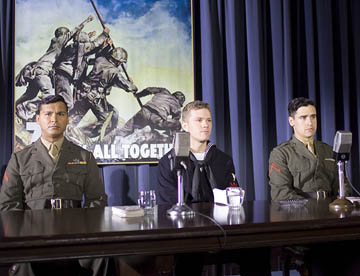 It is during the war sequences that Flags of Our Fathers falters just a little and begins to lose its focus. While the scenes are shot well enough, they do not have quite as much emotional impact as the sequences set back home, mainly because the movie keeps us at an emotional distance from a vast majority of the soldiers. The action is often frantic and confusing, and though I think this was intentional on Eastwood's part, it also sometimes makes it hard to make out the individual people. There are scenes where the three men back home weep over fallen friends, and talk of how they were the real heroes instead of them. But, since we know little of their relationship on or off the battlefield, these moments do not resonate quite as strongly. Even if the war sequences don't hit as hard as they should, they are beautifully shot mainly in grays and blacks. The scenes that take place back home are shot almost like a 1940s film with intentionally somewhat muted colors at times it seems. It is one of the more beautiful films to hit the big screen this year, and the cinematography is almost certainly award worthy. Also of note is Eastwood's own music score which he composed for the film. The music is simplistic, mainly relying on one basic theme, but it is subtle and does not overpower the action up there on the screen.
It is during the war sequences that Flags of Our Fathers falters just a little and begins to lose its focus. While the scenes are shot well enough, they do not have quite as much emotional impact as the sequences set back home, mainly because the movie keeps us at an emotional distance from a vast majority of the soldiers. The action is often frantic and confusing, and though I think this was intentional on Eastwood's part, it also sometimes makes it hard to make out the individual people. There are scenes where the three men back home weep over fallen friends, and talk of how they were the real heroes instead of them. But, since we know little of their relationship on or off the battlefield, these moments do not resonate quite as strongly. Even if the war sequences don't hit as hard as they should, they are beautifully shot mainly in grays and blacks. The scenes that take place back home are shot almost like a 1940s film with intentionally somewhat muted colors at times it seems. It is one of the more beautiful films to hit the big screen this year, and the cinematography is almost certainly award worthy. Also of note is Eastwood's own music score which he composed for the film. The music is simplistic, mainly relying on one basic theme, but it is subtle and does not overpower the action up there on the screen.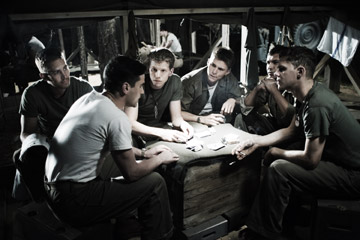 The performances are top notch, as is to be expected. Ryan Phillippe, Jesse Bradford and Adam Beach all give fine turns as their respective characters. The main standout is Beach, who gets the strongest developed character of the three as a tortured Native American soldier who must not only deal with the memories of his actions during his battle, but also with how people react to him both as a "hero" and because of his heritage. His story generates the most emotion out of the three main characters, and he gets the best moments throughout the film. Phillippe and Bradford give good performances, but their characters don't get quite as many strong moments as Beach. This is mainly due to the fact that the screenplay does not dig quite as deep into their characters as I would have liked. They're fine as they are, but I was bothered a little by the fact that the movie seems to almost gloss over their outcome, especially Bradford and his character's reaction to the fame he once enjoyed drying up once the war effort is over, and he is no longer in the spotlight.
The performances are top notch, as is to be expected. Ryan Phillippe, Jesse Bradford and Adam Beach all give fine turns as their respective characters. The main standout is Beach, who gets the strongest developed character of the three as a tortured Native American soldier who must not only deal with the memories of his actions during his battle, but also with how people react to him both as a "hero" and because of his heritage. His story generates the most emotion out of the three main characters, and he gets the best moments throughout the film. Phillippe and Bradford give good performances, but their characters don't get quite as many strong moments as Beach. This is mainly due to the fact that the screenplay does not dig quite as deep into their characters as I would have liked. They're fine as they are, but I was bothered a little by the fact that the movie seems to almost gloss over their outcome, especially Bradford and his character's reaction to the fame he once enjoyed drying up once the war effort is over, and he is no longer in the spotlight.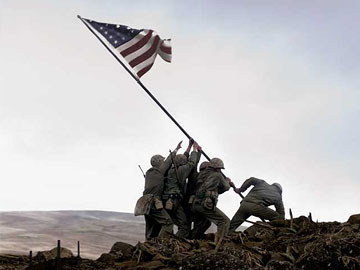
If I seem to be slightly negative to Flags of Our Fathers, forgive me, for that is not my intention. Much like another film I reviewed this weekend, The Prestige, the film is fine as it is, but could have been even better had the film dug a bit deeper. I hold Eastwood to high standards, and he was mostly able to come through. The film is just too familiar for its own good in certain spots, especially with a mainly pointless wrap around segment set in the present day that centers on the son of one of the men writing a book about the incident. Though a bit cliched at times, Flags of Our Fathers is still worth saluting for a number of fine scenes and performances.
See the movie times in your area or buy the DVD at Amazon.com!






0 Comments:
Post a Comment
<< Home